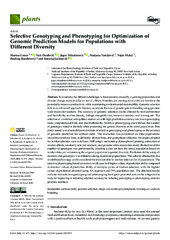Приказ основних података о документу
Selective Genotyping and Phenotyping for Optimization of Genomic Prediction Models for Populations with Different Diversity
| dc.creator | Ćeran, Marina | |
| dc.creator | Đorđević, Vuk | |
| dc.creator | Miladinović, Jegor | |
| dc.creator | Vasiljević, Marjana | |
| dc.creator | Đukić, Vojin | |
| dc.creator | Ranđelović, Predrag | |
| dc.creator | Jaćimović, Simona | |
| dc.date.accessioned | 2024-04-02T12:22:55Z | |
| dc.date.available | 2024-04-02T12:22:55Z | |
| dc.date.issued | 2024 | |
| dc.identifier.issn | 2223-7747 | |
| dc.identifier.uri | http://fiver.ifvcns.rs/handle/123456789/4471 | |
| dc.description.abstract | To overcome the different challenges to food security caused by a growing population andclimate change, soybean (Glycine max (L.) Merr.) breeders are creating novel cultivars that have thepotential to improve productivity while maintaining environmental sustainability. Genomic selection(GS) is an advanced approach that may accelerate the rate of genetic gain in breeding using genome-wide molecular markers. The accuracy of genomic selection can be affected by trait architectureand heritability, marker density, linkage disequilibrium, statistical models, and training set. Theselection of a minimal and optimal marker set with high prediction accuracy can lower genotypingcosts, computational time, and multicollinearity. Selective phenotyping could reduce the numberof genotypes tested in the field while preserving the genetic diversity of the initial population. Thisstudy aimed to evaluate different methods of selective genotyping and phenotyping on the accuracyof genomic prediction for soybean yield. The evaluation was performed on three populations:recombinant inbred lines, multifamily diverse lines, and germplasm collection. Strategies adoptedfor marker selection were as follows: SNP (single nucleotide polymorphism) pruning, estimation ofmarker effects, randomly selected markers, and genome-wide association study. Reduction of thenumber of genotypes was performed by selecting a core set from the initial population based onmarker data, yet maintaining the original population’s genetic diversity. Prediction ability using allmarkers and genotypes was different among examined populations. The subsets obtained by themodel-based strategy can be considered the most suitable for marker selection for all populations. Theselective phenotyping based on makers in all cases had higher values of prediction ability comparedto minimal values of prediction ability of multiple cycles of random selection, with the highestvalues of prediction obtained using AN approach and 75% population size. The obtained resultsindicate that selective genotyping and phenotyping hold great potential and can be integrated astools for improving or retaining selection accuracy by reducing genotyping or phenotyping costs forgenomic selection. | sr |
| dc.language.iso | en | sr |
| dc.publisher | Basel : MDPI | sr |
| dc.relation | info:eu-repo/grantAgreement/MESTD/inst-2020/200032/RS// | sr |
| dc.relation | info:eu-repo/grantAgreement/ScienceFundRS/Prizma2023_BT/6788/RS// | sr |
| dc.rights | openAccess | sr |
| dc.rights.uri | https://creativecommons.org/licenses/by/4.0/ | |
| dc.source | Plants | sr |
| dc.subject | soybean | sr |
| dc.subject | yield | sr |
| dc.subject | genomic selection | sr |
| dc.subject | single nucleotide polymorphism | sr |
| dc.subject | training set | sr |
| dc.subject | breeding | sr |
| dc.subject | genotyping | sr |
| dc.subject | phenotyping | sr |
| dc.subject | populations | sr |
| dc.title | Selective Genotyping and Phenotyping for Optimization of Genomic Prediction Models for Populations with Different Diversity | sr |
| dc.type | article | sr |
| dc.rights.license | BY | sr |
| dc.citation.issue | 7 | |
| dc.citation.spage | 975 | |
| dc.citation.volume | 13 | |
| dc.identifier.doi | 10.3390/plants13070975 | |
| dc.identifier.fulltext | http://fiver.ifvcns.rs/bitstream/id/11931/plants-13-00975.pdf | |
| dc.type.version | publishedVersion | sr |


